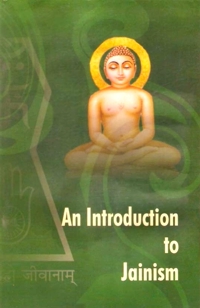Jain Logic
Anekānta
NayavādaWe find the description of the Nāyavāda and Syādvāda in the canonical literature (Āgamas). The term 'syād’ has been used to describe the Naya but the doctrine of 'Anekānta’ evolved later on. The term 'Anekānta' was first used probably by Ācārya Siddhasena 'Divākar' who was one of greatest Jain logicians.
Anekānta is a very important doctrine of Jain philosophy. According to the doctrine of Anekānta, every substance is possessed of infinite number of opposite attributes. When one wants to describe some thing, one of the attributes becomes primary and the others become secondary in his statement. For example, there is a banana. One says that it is green in colour, whereas some other says it is white. Both the perspectives are right. One gives priority to its external colour which is green while other one gives priority to internal colour which is white. If one insists only on his own view, he cannot see the whole truth. Thus, according to the doctrine of Anekānta, the absolutistic view cannot be right.
We can understand the importance of Anekānta through the process of churning curd. After churning the curd, butter comes out. As a matter of fact, the doctrine of Anekānta is like churning. During the process of churning, both the hands do not go together. One hand goes ahead and the other remains behind. As a result, butter is taken out. If both the hands remain adamant on remaining ahead, how will the butter be formed?
Same is with the method of walking. When the left leg moves ahead, the right remains behind. Then when the right goes ahead the left stays back. If any of them insists not to move, how will the movement be possible?
Anekānta can be understood through the example of democracy. Today is the age/era of democracy, where a person, who is the President now, becomes an ordinary citizen after completing his tenure and an ordinary citizen now may become the President in future.
The famous story of "Elephant and the Five Blinds" also illustrate the doctrine of Anekānta. Once upon a time, an elephant came to the village for the first time. The villagers had not seen it till then and were quite unfamiliar with it. Five blind people were also living there. When they heard about it, they went to see it, but due to lack of vision they felt it only by touching it. Each of them touched a part of the elephant's body and insisted on their own experience.
One of them who had touched its tail said, "An elephant is like a rope."
The second one who had touched its leg said, "It is like a pillar."
The third one who had touched its trunk said, "It is like a swing."
The fourth one who had touched its stomach said, "It is like a wall."
The fifth one who had touched its ears said, "It is like a winnower."On the basis of different tactile feelings, their conclusions were different. All of them had touched only one organ of the elephant. Consequently, they insisted only on their own view and kept on fighting regarding the shape of the ant. Just then a person with vision arrived there. On realizing the reason of their dispute, he asked them why are you quarrelling? All of you are blind and you only know one organ of the elephant and not the entire elephant. I will tell you the reality. An elephant is the combined form of all these organs like ears, legs, stomach, trunk, and tail. Each of you only touched a part of it and made your own conclusions, which was only partly right.
Then the blind men understood the reality and repented for their absolutistic views. According to the principle of 'Anekānta', one should take into account all the aspects to understand the whole.
The doctrine of Anekānta is applicable in practical life. Due to absolutistic viewpoints, one is constantly struggling in domains of individual life, family life, social life and political life. In this context, the principle of 'Anekānta' can play a vital role in resolving the conflict. One who adopts the outlook of Anekanta, would listen to others' views, while presenting his own thoughts. When one insists only on one's own views, he would drift away from the truth, but when the person also considers others views, beautiful flowers of truth blossom there.
'Nayavāda' is another doctrine of Jain philosophy. According to this theory, every thought is true from certain standpoint. No idea is false. How liberal this concept is! Whatever philosophies, sects, ideas exist in this world are all true. They become false only when they are absolute. If they are non-absolutistic they are true. This is accommodating attitude of Jain philosophy that gives due importance to other philosophies too.
Mainly, there are tw.o types of nayas, through which we *:an identify each substance:
- Dravyārthika Naya
- Paryāyārthika Naya
The eternal element of any substance and its changing state (i.e., mode) both work in union, both co-exist. The former is realized by Dravyārthika Naya and the latter by the Paryāyārthika Naya. The latter is concerned with 'mode' as the reality, while the former is only concerned with 'permanence' as the reality.
Mahāvīra accepted that both the views are true. Once, Somila asked Mahāvīra whether he was one or many. Mahāvira replied that he was one as well as many. He further said that from the point of view of substance, he was one, and from the point of view of mode (transformation), he was many.
Basically there are seven Nayas (view-points):
1. Naigama the view which accepts both identity and difference. 2. Saṃgraha the view that posits only non-difference. 3. Vyavahāra the view that posits only difference. 4. Ṛjusūtra the view that posits only the state existing at the present moment. 5. Śabda the view which assigns different meanings to a word according to different times or usages etc.. 6. Samabhirūdha the view that assigns different meanings to the synonymous words on the basis of nuances according to their etymology. 7. Evaṃbhūta the view that assigns meaning to a word only on the basis of the present action of the person in which he is actually engaged.
 Sadhvi Vishrut Vibha
Sadhvi Vishrut Vibha

